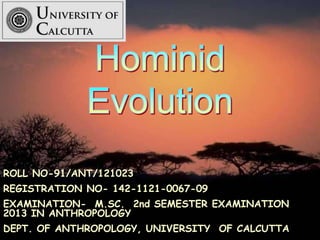
Hominid Evolution
- 1. ROLL NO-91/ANT/121023 REGISTRATION NO- 142-1121-0067-09 EXAMINATION- M.SC. 2nd SEMESTER EXAMINATION 2013 IN ANTHROPOLOGY DEPT. OF ANTHROPOLOGY, UNIVERSITY OF CALCUTTA
- 3. Theories on prehistory and early man constantly change as new evidence comes to light. - Louis Leakey, British paleoanthropologist
- 4. • By the Miocene epoch (25 million to 5 mya) primates in various forms of the modern prosimians, monkey and apes proliferated in many geographic regions. • Sometimes in the late Miocene or early Pliocene, new and distinct forms of primate emerged, classified as the “Hominid”. • The primary characteristics that identified “Hominid” as a distinct genus is the structural anatomy which is needed for bipedalism. • Hominids are generally divided into two genus, those are Australopithecus (emerged first) and Homo.
- 5. 4,000,000 BCE – 1,000,000 BCE Hominids --> any member of the family of two-legged primates that includes all humans. Australopithecines An Apposable Thumb
- 6. • “Australopithecine” are evolved from roughly 4 million to 1 million years ago. After that there is no trace in this genus in the fossil record. • The genus “Homo” includes the direct ancestors of the modern humans. Interestingly this genus coexisted with the later Australopithecines between 2 to1 mya. • The earliest member of the Homo line is Homo habilis (2.2 million and 1.5 mya). The fossil remains of Homo erectus (1.5 mya) is found. Homo sapiens is evolved from Homo erectus and this species encompass modern human during the past 40,0000years.
- 7. HOMO HABILIS found in East Africa. created stone tools. ( “Handy Man” )
- 8. • The hominids are the member of the order primates. As such they share the basic primate characteristics including a generalized skeleton, manual dexterity and prolonged infant dependent. • The hominids have evolved with several distinctive characteristics such asi)Bipedalism, ii)Reduction of face, jaw and anterior teeth, iii)Enlargement of cranial capacity.
- 9. • Bipedalism stands as the earliest and the most important trend in hominid evolution. • Hominids are the only primates that are fully bipedal. Although gorillas and chimpanzee can stand upright but they are primarily knuckle walker. • Many paleoanthropologists believed that the first known hominids were not efficient at bipedalism.
- 10. 1,6000,000 BCE – 30,000 BCE HOMO ERECTUS ( “Upright Human Being” ) BIPEDALISM Larger and more varied tools --> primitive technology First hominid to migrate and leave Africa for Europe and Asia. First to use fire ( 500,000 BCE )
- 11. • Researchers have speculated that bipedalism developed in early hominids because of the changes in the African environment during the late Miocene and early Pliocene. • The climate become drier and dense Miocene forest went away and Savana grassland came into existence. • This type of environment, upright posture may have allowed ancestral hominids to see over the high grass to identify the food source and predators.
- 12. • When bipedalism adapted by the hominids then their hands became free. By using these hands they did some dedicated works such as transfering food, carrying infants, making and using tools. • Some anthropologists attribute the emergence of bipedalism in hominids exclusively for the need to use tool. • But the existing evidence however does not support this hypothesis because early stone tools dated only 2.5 mya but the bipedalism came more than 4 mya.
- 13. • The oldest fossil hominids have prognathas face. Their incisor and canine teeth were large compared to those of modern human. • Approximately 2 mya, these characteristics started to become less pronounced in hominids and early representative of genus Homo have smaller canines and the gaps associated with larger teeth disappeared. • Primate teeth can handle an omnivorous diet. Hominid teeth with fat molar crown and thick toothed enamel are highly speacialized for grinding.
- 14. • Some Australopithecines developed massive chewing mussles and extremely large molars compared to those of humans. (The nickname of A. boisei is “nutcracker man”. • Some Australopithecine fossil specimens have a sagittal crest along the midline of cranium, it grows laeger as more chewing muscles.
- 15. • In the genus Homo, a distinctive characteristics is a tendency toward increased cranial capacity and complexity of the brain, dated around less than 2 mya. • The cranial capacity of Homo erectus was 1000 cc and in case of modern human it is 1350 cc. • Changes in cranial capacity of early hominids undoubtedly influenced physical and social development, increasing brain size, modified human diet, the use of tools, the evolution of language etc.
- 17. Did populations of archaic Homo sapiens simultaneously evolve from H. erectus into modern H. sapiens (multiregional hypothesis)? OR Are all contemporary people derived from one single population of archaic Homo sapiens (“Eve” or “Out-of-Africa” hypothesis)?
- 18. • The multiregional hypothesis is an alternative scientific model that provides an explanation for the pattern of human evolution. The hypothesis holds that humans first arose near the beginning of the Pleistocene two million years ago and subsequent human evolution has been within a single, continuous human species.
- 20. Anatomically modern humans are descended from one specific population of Homo sapiens, replacing populations as they spread out from their original homeland This hypothesis comes from the use of mitochondrial DNA to reconstruct family trees (maternal lineages) Preliminary results suggested that the ancestor of modern humans lived in Africa 200,000 years ago Y-chromosome analysis (paternal lineages) supports the DNA conclusions
